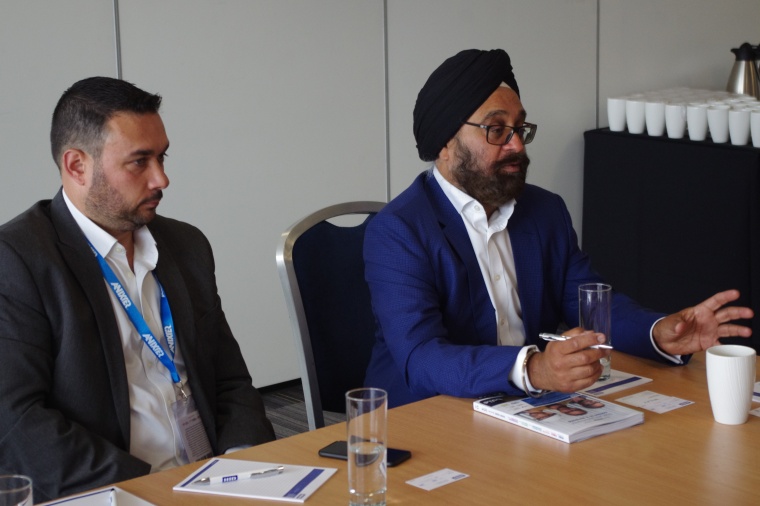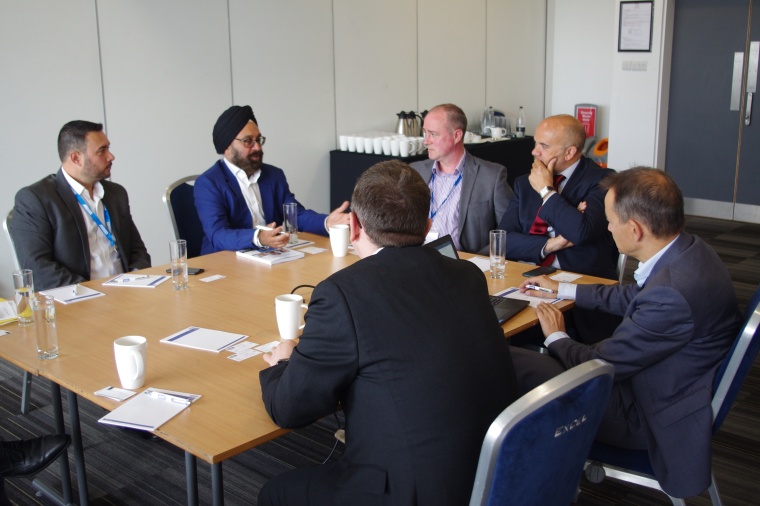GIT SECURITY Industry Talk: Round Table Discussion about Intelligent Buildings
Increasing requirements coupled with decreasing budgets are a main dilemma security officers and building managers are facing today.





Increasing requirements coupled with decreasing budgets are a main dilemma security officers and building managers are facing today. Intelligent buildings can help create a safer and more productive environment, while also being more energy efficient without compromising comfort or the user experience. Sponsored by HID Global, GIT SECURITY hosted a round table discussion at IFSEC in London with leading security consultants about intelligent buildings and the future of access control.
Smart Buildings: Technology is Ready; Budgets and Knowledge Are Decisive
When we asked the security consultants about their thoughts on the emergence of smart buildings, the consultants’ reactions were quite diverse. “The interest is certainly there and there are enough building owners who are willing to invest in smart buildings, but the road from the idea to harvesting the benefits is a long one,” Narinder Dio, Director at CornerStone, explained. He mentioned that the idea of smart buildings is appealing to a lot of people, but when they approach it from a technical and cost perspective, some stop the project. “For a lot of investors who decide to go for a smart building, the situation changes over time. The integration interfaces work on day one and day two, but soon the systems change. To evolve and keep the systems current and applicable is the biggest challenge,” he added.
For Gavin Archery, Head of Security Consulting at AECOM, not only for them as consultants, but for everybody involved in smart buildings, the challenge is this: consultants and planners are signing off on designs that are fantastic, but no one can maintain and manage the system after the installation…and they sometimes get “ripped-off” later. “Clients want smart buildings, but often they don’t have the infrastructure to maintain them and can’t keep the systems at their pinnacle level,” he explains. The right training for the staff, continuous investments and finding people that can work with these sophisticated systems form the required foundation for facility managers and operations teams to keep on top of the game.
“If software and hardware skills are limited within facility management companies, ultimately, they downgrade the systems to the lowest common denominator,” John Psyllos, Senior Consultant at QCIC, added to the discussion. Mark Rowan, Director of QCIC, agreed with this finding. He has seen projects where intelligent components have been taken out of the systems because they were too complicated for the internal teams to maintain and manage. “One has to keep the systems as simple as possible to succeed,” he said.
All of the security consultants at the round table agreed that the benefits of intelligent buildings are certainly there and can be demonstrated to customers. However, the will to invest the time, money and energy and knowledge within organizations are the actual limiting factors, not what is technically possible.
To Improve the ROI, Discipline Plus Technologyare Necessary
Improved ROI over the life span of a building is one of the most powerful arguments for smart buildings, and the security consultants at HID’s roundtable have all seen projects where smart buildings have lived up to their promise. For Narinder Dio, who has over 25 years of experience in this field, the benefits are out of question. At the same time, organizations need management teams with a vision in order to take advantage of the possibilities offered by a smart building and the data it provides.
Gavin Archery of AECOM recognized a trend in engineering consultancy towards smart building concepts: “Smart buildings are a great sales opening since investors find it very attractive. At the end of the day, the key to success is a combination of technology and operational discipline. Technology can work if you are disciplined enough. If not, you are wasting your money.” Sorting out the basic systems (like keys and doors) before starting the thought process around an intelligent building system was another tip we got from the consultants. Equally important is the commitment of the IT and Security departments to work together. For Mark Rowan, the basis for the convergence of IT and Security is to break up the silos in which companies are organized when it comes to budgets, platforms and systems. “We need converged systems financed by separate entities like facility management, security and IT,” he adds. Gavin Archery agrees: “To offer a converged platform to organizations that are not converged will not work – and the approach to sell a converged platform in a fragmented way does not work either.” At the same time, Narinder Dio highlighted that IT directors have a strong position as they command the biggest budgets and there is a danger that security management loses importance.
Intelligence Needs Integration and Skilled Integrators
While convergence of IT and security is an important factor, the convergence of access control and video, or on a larger scale integration in general, is crucial area to consider. For Jason Shaw, Associate Security consultant at Hilson Moram, it is key to integrate new and existing building management systems, solutions, technologies and business processes into one platform to achieve efficient performance and simplified operations. “I see the important role that integrators can play for intelligent buildings. Integrators get more and more technical and more and more IT orientated. This can help us.”
To get the integration work done, consultants and integrators need as much information about the integration interfaces as possible; they also rely heavily on the information exchange with the manufacturers. While in some areas common protocols like BACnet and LON are available, in other areas, the standards are not given or are simply not sufficient (like ONVIF). According to Mark Rowan, the lack of common communication platforms can tie organizations to proprietary systems. With the improvements of VMS, the situation gets better, but is far from other parts of the industry. The more intelligence is going to the edge, the more harmonization is needed. Convergence and a consolidation in the access control and video surveillance market might help here.
Mobility
The role of mobile credentials for security and access control is growing. We asked the experts how mobility is affecting end-user implementations and the way they consult. All of the consultants at the roundtable agreed that this conversation comes up a lot and there is a huge interest in the technology. They believe that the technology is proven, stable and it works, while mass user acceptance still is in the early phase. However, they agree that the foundation for growth is definitively there and it looks like mobile access will be the default in some years’ time.
The consultants pointed out that, generally, the adoption of new technology is slowed down by two factors: old technology is getting cheaper and the lack of standards make the integration more difficult than it should be. In these cases, the role of the system integrator is a decisive one. Gavin Archery observed that manufacturers invest a lot of money in new technology and it may offer compelling advantages, but this is not enough. “Often when we approach installers, they don’t want to use new technology because they don’t have an incentive for adopting it. This creates a barrier between end customers and manufacturers.” Everybody at the table agreed that consultants can play an important role as catalysts for new technology like mobile access.
Boutique system integrators can play an important role in new technology penetrating the market. Mark Rowan explained: “Every proposal for a building that comes out of our office is mobile-credential-ready. We made this decision a year ago. We use HID’s mobile credentials in our office so that we understood and addressed any issues during our own installation. Particularly for enterprise clients with 40 to 50 thousand credentials, mobile is a natural move and we are pushing it. Biometrics will also be a focus down the line.”
All agreed that mobile access only makes sense when integrators are prepared for the database integration moving to the cloud. Additionally, according to John Psyllos, the situation changes when you look at enterprises that have developed their own App that includes mobile credentials, mobile tracking, intelligent functions and integration
into HR systems.
Legacy Buildings
Asked about the situation when it comes to legacy buildings, Narinder Dio explained that they are often asked to do a security review and propose a modernization project when the existing products are at the end of their lifecycle. The challenge starts when the client asks for a “future-proof” solution but wants to use old cables and equipment, if possible. “They know modernizing would be the right thing to do, but it has a direct influence on their earnings,” he explains, “In most cases, they only invest in new systems, equipment and cards if there is a vital threat, or politics or regulations like GDPR act as catalysts. But there is another argument for new systems: According to Jason Shaw the chances for such an investment increase when the experience for visitors or employees plays a bigger role – not only security. No company wants their visitors and employees to get the impression that they use outdated, inconvenient or even unsecure systems. Seamless yet more advanced security can be another driving factor in those countries where privacy issues and regulations such as GDPR are a major focus.
When the Millennials Take Over
In the future, we can expect more modern systems, mobile access solutions and new services like indoor positioning in our buildings, simply because a new generation with a different lifestyle and expectations will be working on it. Mark Rowan sees a clear trend: “People want open spaces and seamless areas. Younger people and new concepts are the drivers.” When the Millennials are taking on their role as decision-makers, the situation will change. Co-working spaces have changed the landscape, and Millennials are asking for a collaborative workstyle. Open space, Bluetooth indoor
positioning services, and other technologies that enhance the user experience will attract the talent of the future. For example, new technology can provide organizations with visibility into the location of their workforce in a facility, making it
possible to analyze room usage for better building management, increased operational efficiency, and ultimately a better experience for the workforce.
Conclusion
Intelligent building solutions are certainly the future in our industry as there are numerous benefits and a strong demand from customers; however, they will by no means be given in a generally difficult environment. The high level of integration,
which is the basis for everything, needs to be sustained over a long period of time to deliver the promised ROI. This is only possible when consultants, integrators and the relevant departments on the customer side work together and are committed to the common goal, not only in the planning and installation phase but also in ongoing operations. A strong relationship with the manufacturers of security solutions and open communication between all shareholders can bridge and shorten the time between the development of groundbreaking technologies like HID Mobile Access or
HID Location Services and mass market adoption, which will ultimately help to make our lives safer and simpler.
most read

GIT SECURITY AWARD 2026 - The winners have been announced!
GIT SECURITY AWARD 2026: The best safety and security solutions of the year - now an overview of all winners

When the Internet stumbles: Why DNS is important
When DNS fails, the internet stumbles-AWS outage proves resilience and redundancy are vital for digital trust



Assa Abloy's battery-powered Aperio KL100 secures lockers
Boost workplace security and operational flexibility by securing more than just doors.








